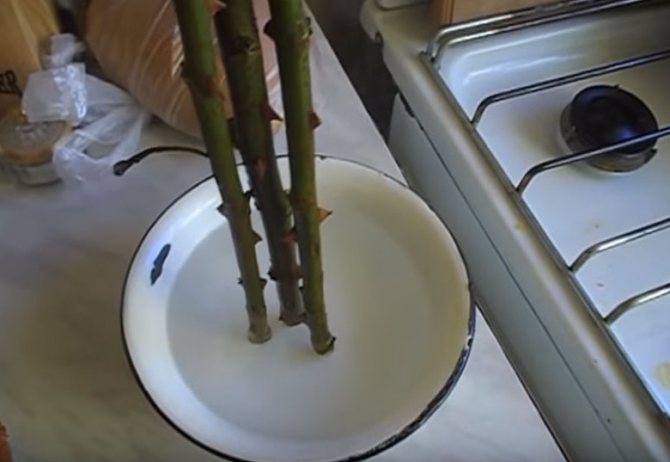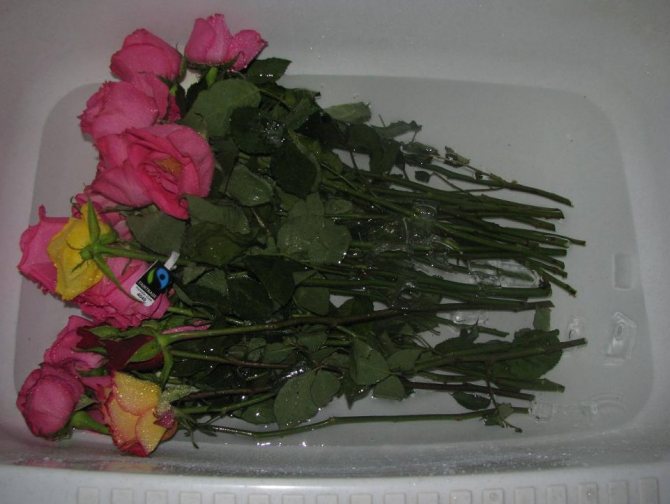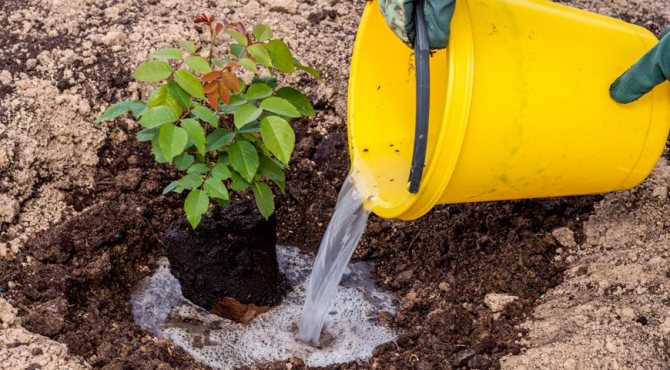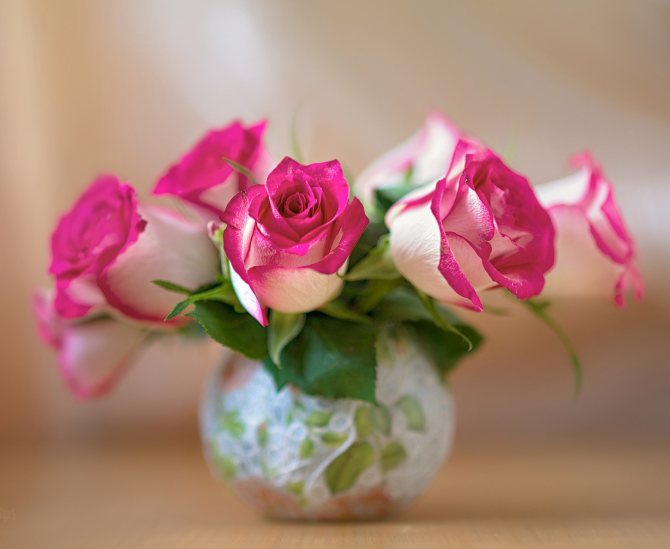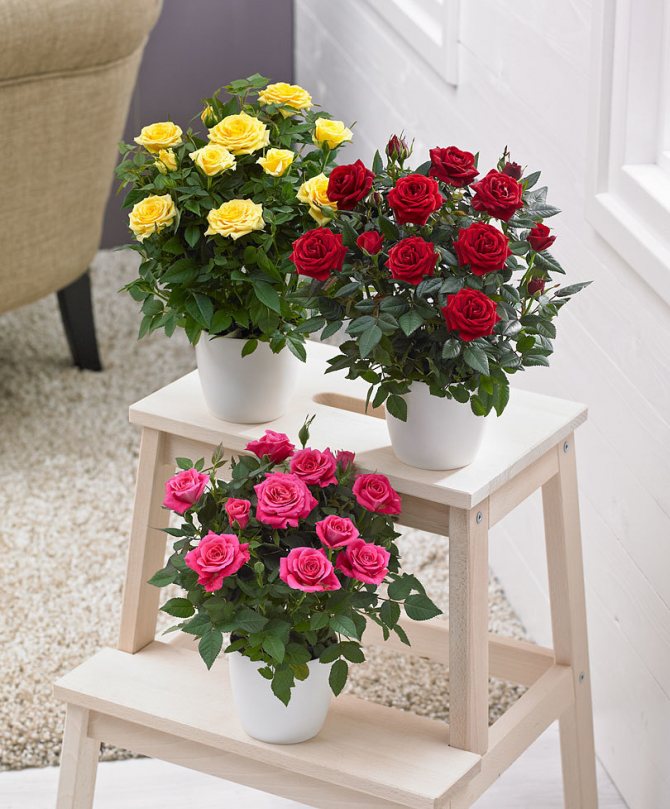
Roses are grown not only in the garden, but also indoors. Florists appreciated the efforts of the breeders, who presented the opportunity to keep such flowers on the windowsills. These miniature copies of garden representatives do not leave anyone indifferent, only special care is required for these plants. Indoor roses dry up, often get sick, and are demanding about the conditions of detention. To save a beauty from death, you should know how to care for her.
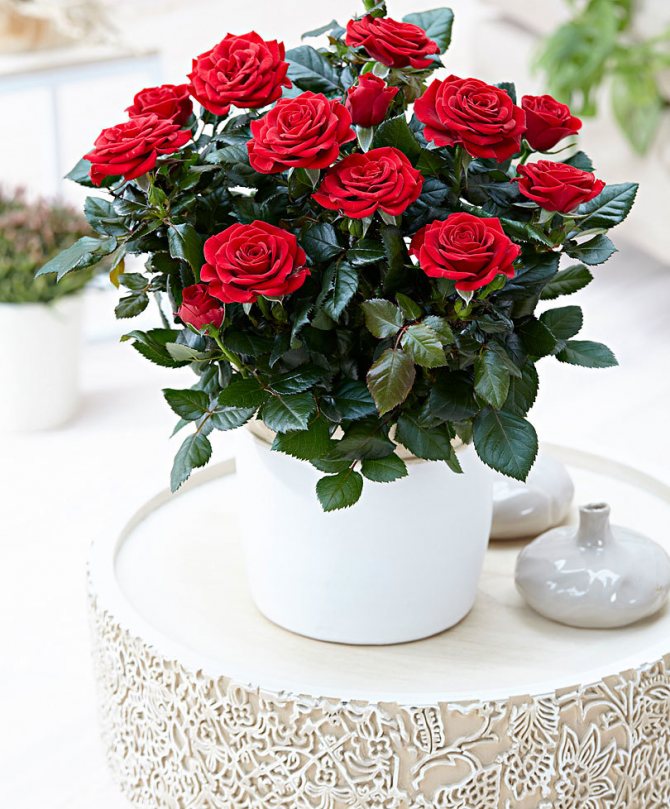

Fresh flower care
It is not difficult to distinguish such flowers from those that have stagnated on the counter. They have a healthy stem, without darkening, green leaves and shiny and elastic petals tightly pressed together. The bouquet brought home must be acclimatized. This is especially important if it is cold outside. To do this, leave the flowers unopened in the coolest room for a few hours.


How to properly care for a flower to prevent drying out
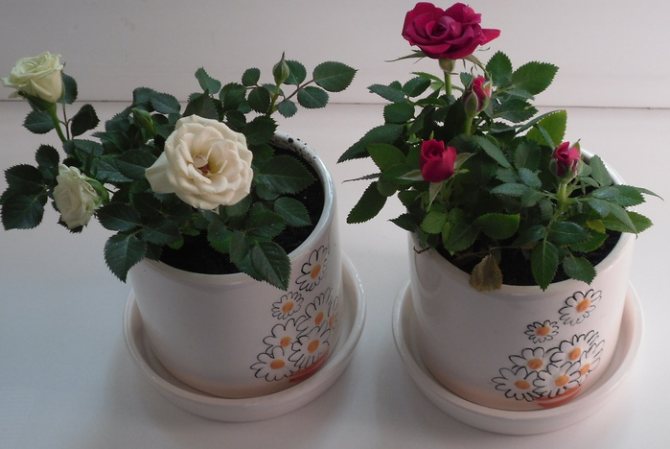

To prevent the indoor rose from drying out, it is necessary to provide it with proper care.
- Indoor rose is one of the light-loving plants, so the best place to place it is the sill of a south-facing window.
- In the absence of such an opportunity, she will have to provide additional illumination with the help of a phytolamp.
- The room temperature should be maintained at 18-25 degrees.
- To ensure full development in the warm season, it is advisable to take the pot with the plant out into the fresh air (in a secluded corner of the garden or on the balcony).
- The room where there is a pot with a rose must be regularly ventilated, in every possible way avoiding the occurrence of drafts.
- To water a room rose, you must use tap water at room temperature, standing for 24 hours. Knowing that the flower does not like lime, some growers water it with boiled water.
- A plant that does not tolerate dry air must be sprayed daily, if possible, doing this in the evening hours.
- You can revive a capricious plant with the help of regular (at least twice a month) fertilizing with complex mineral fertilizers.
- Experienced flower growers recommend using liquid complex fertilizer "Bona Forte" for feeding home roses, once a week watering the flower with a solution of this preparation, and the next - using the same solution for spraying the leaves. Throughout the growing season, such watering and spraying must be alternated.
- Once a week, it is necessary to treat the roses with a solution of Fitoverm insecticide.
- To form a beautiful bush, the plant needs periodic pruning, consisting in the removal of dry inflorescences and twigs, as well as shoots that have grown over the winter and violate the correct shape of the crown. They are best done during the spring months.


An indoor rose growing in a pot or greenhouse can get sick, wither, or stop blooming.
Without proper help, all these problems entail the death of the home flower.
Further in the article, we will tell you the most common reasons why a flower disappears in a pot, and also give recommendations for resuscitating a room rose.
Some tricks
Place the bouquet in a vase with settled water, this will reduce the effect of chlorine on delicate petals. Choose the place where he will stand carefully.Despite the desire to admire them day and night, flowers should not be placed next to heating devices (radiators) and open windows, drafts are destructive for them. Directional sunlight also promotes rapid wilting.


Tips on how to bring roses to life in a bouquet:
- Don't forget to change the water. Bacteria contribute to the rapid death of flowers. Renew the cut each time (remove leaves that become under water as the stem shortens).
- Spray roses with a spray bottle.
- At night, put a spacious bag on the bouquet, sprinkled with water from the inside.
- Add sugar to the water (20 g per liter of water) - this will allow the roses to last longer.
What is the resuscitation of flowers wilted in a vase of water?
Resuscitation of roses in a vase is a return to the flowers of their original appearance using a variety of methods and means, after they began to fade in the water.


Flower resuscitation is different from conventional care measures, which are to prevent premature drying and wilting of rose buds and leaves. The care is carried out in order to maintain the beautiful appearance of the bouquet, when it was just brought into the apartment and before being placed in a vase of water, by preparing the stems, water and choosing a place. And resuscitation is used when they want to save flowers that have begun to wither.
The first signs of wilting
Sooner or later, you will still notice how the petals of your beauties begin to dry out and curl. Now the question of how to reanimate roses becomes more acute. But it's still fixable.


How to revive roses in the bathroom? Very simple. It is enough to fill it with cold water and immerse the stems of flowers there. The inflorescences should not be in water, otherwise the petals will turn black. It's easy to make a lifebuoy out of a piece of Styrofoam. Make holes in it, into which you insert the stems. Situated under the flower, this material will not allow it to get wet. Cover everything on top with paper. In the morning, place the refreshed and rested roses in the vase of fresh water again.
Doing this procedure every day, you will notice that the bouquet will last for a very long time.
Step-by-step instructions: how to save flowers if they wither?
With sugar and fertilizer
If the flowers show signs of wilting, you need to start resuscitation with the water in which the bouquet is. It is necessary to use only settled water.


The water must be changed every day and all the time before immersing the flowers in the vase, the stems must be rinsed to avoid the development of bacteria and rot.
- In order for the roses to receive all the necessary substances and retain their appearance for a long time, white sugar (for 1 liter of liquid - 20-40 grams) and fertilizer for flowers (1 tablespoon) are added to a vase of water.
- Instead of fertilizing with sugar, you can add a pinch of citric acid or a teaspoon of 9% vinegar.
- Under water, you need to cut off the stems at an angle, and also remove all leaves and thorns.
- It is recommended to cover the cut until the rose is placed in the vase so that air does not get into the fibers of the stem, as it can create an invisible barrier to water. This process makes it difficult to feed the flowers.
Using a silver item
Mucus forms on the part of the stem that is in the water.
The mucus is caused by bacteria and this means that the rose has begun to rot. To prevent this process, it is recommended to place any silver object (coin or ring) in the vase. This will stop stem decay and give the flowers a fresh look.
If the celebration is postponed
For various reasons, the delivery of the bouquet may be postponed (for example, to the discharge from the hospital). How to revive cut roses and keep them intact? Storage on the bottom shelf of the refrigerator is best. To do this, completely immerse the stems of the roses in water for 3 hours, then wrap them in a wet cloth, wrap them tightly in newspaper and put them in the refrigerator.Be sure to monitor their condition. Repeat daily bathing in water (warm, so that it rises better through the vessels to the leaves and petals) and renew the cut.
The soil
Soil for roses must be nutritious. You can do it yourself or purchase a ready-made substrate for indoor species.
When self-made, take humus and sod in equal parts, add sand, mineral fertilizer.
Care after buying a rose in a pot requires the right choice of container for planting. It should be light so that the root system does not overheat in the summer.
If you provide an indoor flower with all the necessary conditions, the rose will bloom for a long time and profusely.
When a rose's life comes to an end
With the right care and the described procedures, you will significantly prolong the life of delicate beauties. But there comes a time when they stop helping. Now there is nothing to lose, and you can proceed to the most drastic measures. Talking about how to revive wilted roses, there are four most effective remedies.
Number one is boiling water that is completely incompatible with fresh flowers. Nevertheless, experienced florists advise it as the last option. You will need exactly bubbling boiling water. Remove the pot of boiling water from the stove and lower the tips of the stems in it a few centimeters. Cover the flowers and leaves with paper in advance to prevent the steam from burning them. After two minutes, the flowers can be taken out, cut a little higher than the burnt place and placed in cold water.
This method is often advised by flower sellers when they are asked how to revive roses, but because of its originality, not everyone decides on such a measure. As a reminder, this is an option for already fading flowers, so you won't lose anything, even if you fail. If everything goes well (most often this is possible, when such procedures have not yet been carried out with these roses), then you will be presented with another week of the bouquet's life.
The second number is the addition of saltpeter to the water (a teaspoon for 4 liters of water), a few drops of ammonia or chlorine (any cleaning agent). Such supplements can be done after the boiling water rejuvenation procedure. They will help extend the life of the rose for a few more days.
Why do roses in a pot dry up: reasons
The culprits for the poor health of potted roses, as a rule, are mistakes made when caring for them. To prevent the death of plants, in each case it is necessary to find out the cause of their ailment.
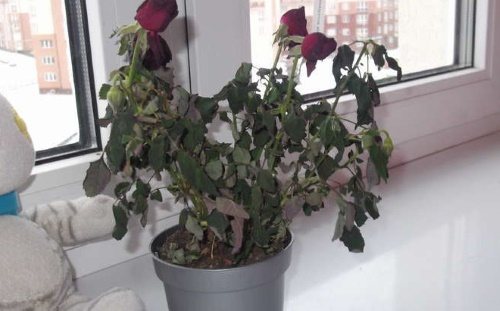

Indoor rose in a pot most often dries up due to:
- Low level of air humidity in the room.
- The close location of heating appliances.
- Improper organization of watering. Frequent watering or using too cold water can cause root rot.
- Serious damage to the root system, preventing the supply of nutrients to the plant.
- Exposure to cold air (if the plant pot is in a draft).
- Acute lack of trace elements and nutrients in the substrate (nitrogen, potassium, iron, etc.).
- Insect attacks.
- The high density of the soil in the pot, which prevents the normal flow of oxygen to the roots.
- Lack of lighting.
- Too frequent spraying (some varieties of roses react to this by yellowing and falling leaves).
Intensive leaf fall is also observed during the period when the plant begins to prepare for wintering.
Brief conclusions
Fresh roses, with proper care, can last in a vase for about a month. To do this, change the water regularly, monitor the temperature regime and the absence of drafts. With the first signs of wilting, start using a night bath, this will prolong the life of the flowers for several more weeks.And finally, you can apply shock resuscitation procedures to admire the beauties for a few more days.
A bouquet of roses is always an appropriate and very pleasant gift. But after standing for a while, the flowers begin to wither. And sometimes it happens pretty quickly. Fortunately, there are ways to bring back life to fading flowers and extend their decorative period. In the article, we will consider all the ways to resuscitate roses that begin to dry up at home.


Diseases and pests
Indoor roses are most often affected by pests. Aphids may appear on the tops of the stems. To get rid of it, it is recommended to treat the plant with special preparations, of which there are many on sale, for example, "Intavir".
Some growers carry out the prevention of indoor flowers with soap or garlic solutions. However, they do not always give the desired result.
Indoor roses are often infested with spider mites. This pest is able to destroy a large bush in a matter of days. To cope with the mite, the bush should be treated with special preparations, for example, Fitoverm, and the level of humidity should be monitored. The affected plant is quarantined until it recovers completely.
With stagnant humid air, the rose is affected by fungal diseases: powdery mildew, rust, rot. Fundazol, Topaz and other fungicides help to avoid plant contamination. You should also avoid dense plantings, wetting the leaves with water during watering. Airing the room helps to cope with stagnant humid air.
The processing of domestic roses and other plants is carried out outdoors. If this is not possible, then it is carried out in a well-ventilated room. After processing, the plant is given time to "ventilate" and only after that it is brought back into the room, the pot is put in place.
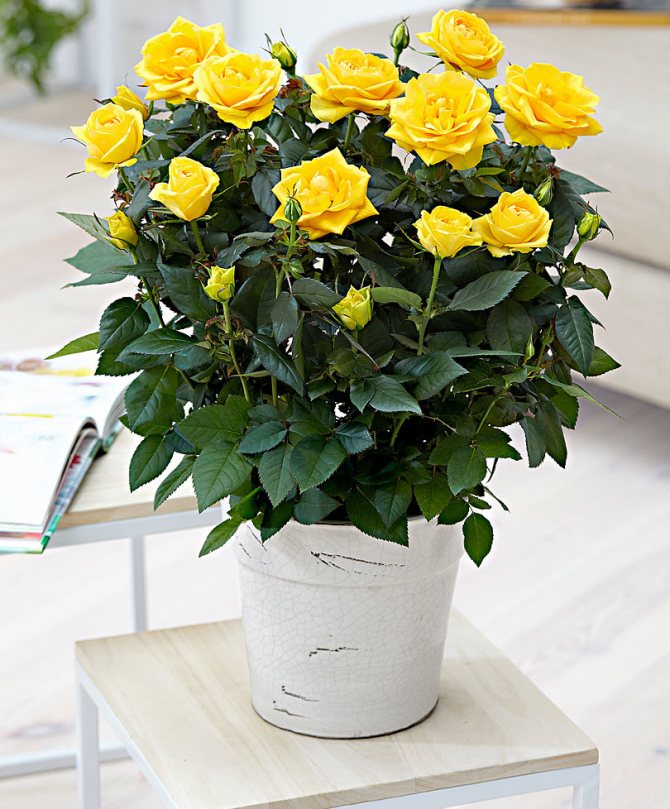

How to extend the life of a pink bouquet
We will find out with the help of what manipulations you can significantly extend the life of roses standing in a cut.
The water in the vase should be changed regularly. At the next change, it is recommended to update the cut at the bottom, while removing thorns and leaves (which may end up in the water).
In order for the leaves to delight you with their freshness and elasticity for a long time, we recommend spraying them periodically from a fine spray.
You can nourish cut roses and extend their "life" by adding to the water:
- a tablespoon of granulated sugar;
- an aspirin tablet;
- a teaspoon of lemon juice (or powdered acid).
Before going to bed, cover the bouquet with a plastic bag dipped on the inside with cool water. You can moisten it by simply spraying it with polyethylene.
When is it required?
You can determine when flowers need resuscitation by the appearance of the rose. in a vase. The first signs are buds that have wilted, and leaves that have begun to curl, change shape and appearance. In addition, the bouquet loses its wonderful aroma.
A number of ways in which you can save a bouquet of fragrant roses are:
- in the use of various chemicals or drugs;
- using silver items, potato juice, cold;
- as well as the addition of fertilizers and other nutrients.
First aid for wilting
After standing in all its glory for a while, the roses then inevitably "give up their positions" and begin to fade. Signs of the onset of wilting:
- curling the edges of the petals and drying them;
- lowering the buds down;
- lethargy foliage;
- loss of saturated color by the stems and their more sluggish structure.
The first aid in the beginning of wilting is most convenient to provide in the bathroom. Standard resuscitation involves the following procedure:
- The bathtub must be filled halfway with cold water.
- Cut the stems obliquely to increase the absorbent area.
- Flowers are placed in water. But at the same time, the buds should remain above the surface of the water - they will need to be fixed with something.
- Roses should be kept in water under a film cover. This will make it easier to revive the flowers.
- The bouquet should be left in the bath overnight. In the morning, refreshed roses can be collected again in a vase.


You can do this simple manipulation every evening: in this way the roses will stand much longer. But if the flowers still look wilted by morning, try adding a few tablespoons of ammonia to the water. This additive will stimulate flowers, activate their vitality, and serve as a kind of "stun gun" for plants.
What to do if a rose in a pot dries up?
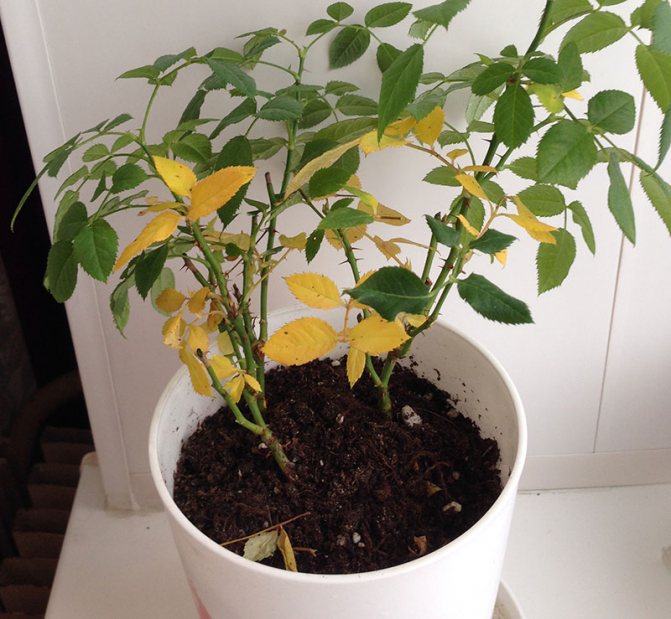

- If a profusely flowering bush, recently brought from a store or received as a present, suddenly began to drop its leaves, do not panic, feverishly rearranging it from place to place or increasing watering. In a similar way, the plant is most likely simply responding to new conditions of detention. A pot with a freshly purchased room rose must be placed in a well-lit, warm place that excludes the occurrence of drafts. The best option for its placement is the sill of the southeast or east window. After the rose gets used to the new environment, the leaves will stop falling.
- It is much worse if the wilting of flowers and unopened buds is observed, and the leaves not only fall off, but also turn black. This symptomatology is typical for plants exposed to freezing, fungal infection or attack by insect pests. That is why the pot with the newly purchased rose should not be placed on the same windowsill with other indoor plants. It is better to keep the flower separately for two weeks, carefully monitoring its condition.
- Homemade rose dries in an overly hot room. You can cope with this problem by placing the flower pot in a pallet filled with wet expanded clay or removing it away from the central heating battery, while not forgetting to control the degree of soil moisture in the pot. If it turns out to be insufficient, the flower must be watered, and then the leaves must be sprayed with a spray bottle.
- Very often, indoor roses dry out due to decay of the root system, provoked either by too frequent watering, which led to waterlogging of the soil, or by the presence of an excessively dense substrate that does not have time to dry out after the next watering. What to do in this case? Having freed the roots from the old soil, the rotten areas (they will be soft, black-transparent) must be removed, and the healthy ones should be washed in a weak solution of potassium permanganate. After that, the root system is kept in a solution of the fungicidal preparation "Fitosporin-M" for half an hour. Taking a bush from a container with a solution, the roots are dried in air for two hours, and then transplanted into another pot filled with fresh, fertile and loose soil. The transplanted rose is not watered, but only sprayed once a day. Ten days later, the plant is watered with a solution of the same fungicide.
- If the root system of a room rose is irretrievably damaged, you can cut several cuttings from the bush and try to use them for further propagation of the plant.
- If the leaves of indoor roses have begun to turn yellow, you need to check the soil in the pot: it may be waterlogged. In this case, you should refrain from watering for a while, limiting yourself to spraying the leaves. If there are signs of soil acidification, the rose is transplanted using a specialized substrate purchased at a flower shop (it is better to refuse to use garden soil). A yellowing rose can be fed with a complex fertilizer (Bona Forte and Greenwold give good results).
- Evidence that a rose dies as a result of an attack by parasites (thrips, spider mites or aphids) is the appearance of cobwebs, eaten or speckled with dark dots on the leaves, as well as the appearance of insects that are well amenable to visual observation. It is possible to cope with pests with the help of insecticidal preparations "Actellik" or "Fitoverm" (several treatments will be required with a seven-day break).
- There is an easy way to get rid of a spider mite from a indoor rose. Thoroughly soaping the sponge with a bar of laundry soap, the resulting foam is generously applied to the stems, leaves and soil surface. After half an hour, the foam is carefully washed off with running warm water from the shower head.
- If home roses wither as a result of aphid infestation, you can resort to the help of an infusion made from orange peels, drenched in boiling water and infused for 48 hours. After spraying the leaves of the affected plants with undiluted infusion, they are covered with cellophane film and left for the whole night. In the morning, the film is removed. New leaves on the bushes appear, as a rule, by the end of the second day. To prevent the appearance of new parasites, the treatment can be repeated.
- Clarification of the leaves of indoor roses can be the result of chlorosis. You can cope with the disease by feeding them with a mineral fertilizer containing a full set of trace elements.
- What to do if the indoor rose has dried out as a result of damage to the root system? You can resort to the help of stimulants of root formation, represented by the drugs "Heteroauxin" or "Kornevin". The roots of the plant, removed from the pot and freed from the soil, are placed in a container with a freshly prepared solution for 6-8 hours. After this time, it is transplanted into another pot using a light fresh substrate.
- If the newly acquired indoor rose sheds its leaves too intensively, you can, by shortening the branches by 5-6 cm, pour it with a solution of a growth stimulator (it is best to take "Epin"). This manipulation will help the plant cope with stress faster. To prevent the occurrence of chlorosis, after 15-20 days the same plant must be watered with a solution of Ferovit. Every 15 days it will be necessary to water it with water acidified with lemon juice (3-4 drops of juice per 100 ml of water).
- If, in spite of the whole complex of measures taken, the wilting of the leaves continues, and the green shoots dry up, becoming wrinkled and brown, the soil in the pot can be watered abundantly. The above-ground part of the bush must be immersed in a basin of cool water and left in it for two hours. You can do it easier by placing a pot with a wilting rose in a basin of water. The liquid will enter the soil through the drainage holes at the bottom of the pot.
Rose resuscitation methods
Consider the most effective and simple ways to revive roses at home.
Boiling water
If urgent measures need to be taken - when the roses have already noticeably wilted, you can lower the lower part of the stems in boiling water. Immerse in liquid no more than 2-3 cm of the stem, and the time spent in boiling water is 2-3 minutes, no more.
Important: before dipping the stems into boiling water, you must protect the delicate buds from steam. For this, the flower heads are unwound with a soft cloth.
After such "shock therapy", the part of the stem that was in boiling water will darken - it should be cut off with a pruner. The living lower part of the stems is immersed in cool water. The measure will help keep the bouquet for another week, or even longer.
Silver
This is a popular method of extending the life of cut roses. A small silver object is lowered to the bottom of the vase. The metal is known for its disinfecting properties: it is they that help the flowers last longer. To supplement the positive effects of silver, you can add a little glycerin or camphor alcohol to the water.
Chemical detergents
Many people know such a simple way to resuscitate roses in a bouquet, like pouring a drop of dish detergent or liquid bleach into the water. It is better to add funds at the next water change.
Bleach must contain bleach. Avoid just getting the bleaching agent on the petals, as the bleach can leave a whitish, ugly stain on them.
Alcohol method
This method will help to revive even a fairly dry bouquet. Stir alcohol in water: half a spoon in a liter. After that, ammonia is also added to the water, which enhances the positive reanimating effect. Roses are placed in the resulting alcohol solution: in this way, even heavily wilted flowers can be brought back to life.
Cold exposure
Since by nature roses are thermophilic flowers, the cold affects them like a shock therapy, keeps them in good shape, does not allow them to become limp, and wither too quickly. This ability of cold can be used when resuscitating flowers at home.
The bouquet should be wrapped carefully with a soft towel: from the tips of the stems to the tops of the buds, that is, completely. Then the bundle is still wrapped in newspaper and placed in the refrigerator. Roses should be refrigerated overnight. Flowers should be fresh and “rested” by morning.
Very cold water can also bring flowers in a bouquet back to life. To do this, change the water in the vase and pour ice cubes onto the bottom of the vessel. Refresh the cut stems and place the roses in the vase. If you use ice daily, you can keep the bouquet fresh for a week or more.
Potato juice
The method is not bad, it can be used even if there is not a drop of water suitable for flowers left in the house.
In this case, the stems cut according to the standard rules are stuck into fresh potatoes. It is clear that the potatoes must be washed before use.
Potato pulp, nutritious and saturated with moisture, will help to revive flowers, even those that are very wilted and have stood for a long time without water. Potato juice can also be added to water to make it more nutritious.
Saltpeter
This substance will help bring back to life already pretty wilted flowers. However, saltpeter will be effective only after the roses have been treated with boiling water.
The proportion is as follows: 1 teaspoon of saltpeter in 4 liters of water. A few drops of ammonia should be added to the resulting solution. Rose stems are placed in the resulting "explosive mixture". If the procedure is carried out in the evening, then by the morning the roses will be "as good as new" and will stand fresh for several more days.
Hanging method
This can be said to be an extreme measure in the resuscitation of roses. The method is applied if all others have not helped. Flowers need to be removed from the water and hung down in buds. Dried upside down buds will acquire the correct beautiful shape - almost the original. After drying, the plants can be varnished and stored as decor for interior decoration.
How to revive roses that have begun to fade
Cut or purchased flowers can last longer than a few days with a few tips, but even then there comes a time when the rose begins to wither. It's time to move on to more decisive measures to revitalize the bouquet. There are several ways to restore freshness to flowers for a few days:
- using boiling water;
- adding saltpeter;
- a vase of cold water and ice;
- a mixture of water and ammonia;
- bleach or detergent.
Not everyone dares to revive roses with boiling water, because hot water harms flowers. You can heat the water in a saucepan and lower the cut flower stalks into boiling water, after covering the leaves and buds with paper to avoid getting burned. The second way is place roses with cut stems in a fireproof vessel, pour a small amount of boiling water, covering the neck of the container with a towel.The thicker the stem, the longer it takes for the rose to recover, but the stems should be kept in hot water for no longer than a few minutes.
This method will allow the bouquet to remain fresh for another six to seven days.
Saltpeter helps revive wilted flowers. It should be used after the procedure with boiling water. A teaspoon of saltpeter and a few drops of ammonia are added to four liters of liquid, the cut stems are placed in this solution. By morning, the bouquet will have a fresh look that will last for several days.
Withering flowers can be revived using cold water and ice. Since roses do not like excessive heat, they need to be placed in a vase, on the bottom of which ice cubes are poured, and filled with plenty of cool water. The cut on the stems is pre-updated. After a few hours, a noticeable improvement in the condition of the roses can be observed. Using ice daily will keep the flowers fresh for about a week.
How to revive roses with rubbing alcohol? Cut wilted flowers can be used to revive ammonia or rubbing alcohol. A teaspoon of alcohol is dissolved in warm water, fill a vase with it and lower the bouquet. Ammonia can be replaced with natural lemon juice, vodka, or aspirin. Lemon juice, a few tablespoons of juice or three or four aspirin tablets are mixed with water, poured over the stems of the bouquet and left overnight.
Although chlorine-containing water is harmful to roses, chlorine bleach or detergents can help revitalize flowers. It is enough to add a few drops of the product to a vase of warm water and flowers, and the bouquet will retain its fresh appearance for several more weeks. It is important to be careful when using these products and not let them get on the leaves and petals of roses, as they may leave white spots.
Roses can wither immediately after purchase... This means that the flowers have stood on the counter for too long, spent a long time in the cold or draft. In this case, you can refresh the flowers at home with warm water, ice and cold liquid are better not to use. If a bath with warm water does not help, then it is better to use boiling water. After resuscitation, the frozen flowers will live for several more days.
You can keep the fresh look of the bouquet longer if you follow a few tips:
- before you put the flowers in the water, you need to clean it. To do this, place several tablets of activated carbon or any silver object at the bottom of the vase, or add one teaspoon of alcohol, glycerin or vodka;
- at night, the bouquet is covered with paper from all sides to protect it from low temperatures, the flowers are placed in a bath of cold water or the stems are wrapped with a wet cloth;
- place the vase with roses in the shade and away from the fruit. Fruits release substances that accelerate the wilting of roses.
Completely withered roses that have not recovered after resuscitation at home can be dried. Dry buds are varnished or paint and used as decoration for rooms.
Advice


Several recommendations to help prolong the life of a pink bouquet.
- To prevent the roses from fading too quickly, it is recommended to cover them on all sides with damp paper or polyethylene at night. This measure will help to significantly extend the life of cut flowers.
- Place the bouquet not in the sun or near working batteries, but in the shade.
- Cut roses should not be kept near fruits: such a neighborhood leads to the rapid fading of flowers. The fact is that the phytoncides secreted by fruits contain substances that accelerate the rotting of roses.
- Sugar in the amount of a teaspoon per liter of water will help the roses stand much longer, nourish them, and give them new strength.
- Placing an activated charcoal tablet on the bottom of the vase will help keep the water clean and disinfect it.
- If you bought a bouquet as a gift in advance and you need to store it for several days, place the roses in the refrigerator. Pre-wrap the plants with a towel and newspaper, paper.
Description of the plant
Indoor rose belongs to the same family as its garden sister - Rosaceae. In height, it reaches a maximum of half a meter. Among the indoor varieties there are creeping, intended for growing in hanging pots, and bushy. The latter are the most common.
The leaves of the rose are carved, depending on the variety, they can be dull or lanceolate. Flowers in plants are of different sizes: small, medium, large. The color of the buds is very diverse - from white to black. There are monotonous, two-, three-color varieties. Flowering can last all year round. Some varieties can shed their leaves. When growing such species, flower growers begin to sound the alarm, looking for answers to questions, why does the rose dry, why does it shed its leaves, without thinking that this may be a natural process.
Indoor roses are propagated by cuttings.


First steps
The presented bouquet of cut roses can stand in water from a couple of days to several weeks. It all depends on the condition in which the flowers were purchased and how they were looked after after the purchase.
After you have been solemnly presented with a pink bouquet, it should be immediately placed in a vase, well, or in any other container filled with water. Examine the bouquet - freshly cut flowers will delight you with dark, saturated green stems, elastic foliage, petals tightly pressed to each other.
To make the flowers better adapt to new conditions, leave the bouquet unopened for several hours. Thanks to this measure, roses can more easily adapt to room temperature. Then you can unpack the flowers and examine them in more detail. Remove the packaging completely, and free the lower part of the stems from the existing thorns. Thorn removal aims to protect the underside of the stems from rotting in the water.
Renew the cut with a sharp secateurs or a knife: it is important to make a new cut in one stroke so that the stem does not get soaked. Thanks to a fresh cut, roses will be able to absorb more water, which will have a positive effect on their appearance.
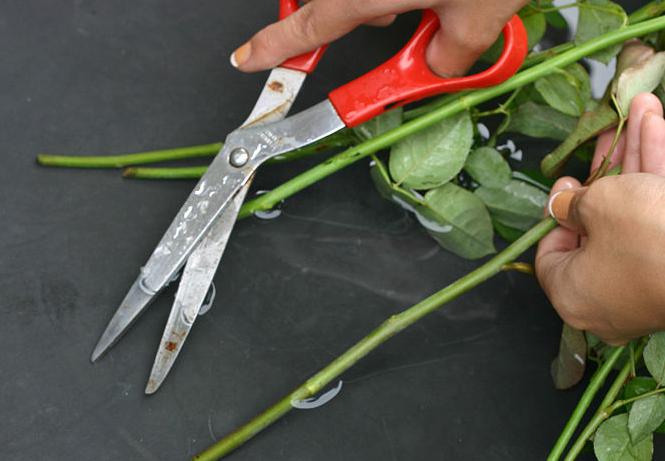

The cuts are made at an oblique angle - approximately 45 degrees. An oblique cut will make the area of absorption of water and nutrients more extensive, which will help the roses stay fresh longer. It is necessary to cut the stems directly in the water to avoid air getting into the vulnerable place of the cut and into the stem.
Then move the peel back a little from the edge of the cut: by 2-3 cm. This measure will increase the absorbent area of the flowers, and they will receive more moisture and nutrients.
The water in the vase must be settled. If it is necessary to use tap water, it must first be defended.
Roses are delicate flowers, so they must be kept away from drafts and cool breezes from the vents, windows. It is also undesirable to put a bouquet near a working heating battery - flowers will dry out in such a place very quickly. If you want to put roses on a windowsill, protect them from direct sun. The best place for a bouquet of roses is a room with a relatively cool temperature, high air humidity and diffused lighting.
How to properly care for them?
To make the purchased bouquet look presentable again, you should pay attention to the contents of the vase. The water in it should be settled, and its change with joint washing of the stems should take place daily. Any package of the bouquet creates favorable conditions for the development of bacteria, so it should be removed immediately.
The cut is made at an angle of 45 degrees with a pruner or a sharp knife. The stems of roses are cleaned of leaves and thorns, preventing their decay.Pruning roses is carried out under running cold water, not allowing the fibers to dry out.
Proper care of purchased flowers will maximize their flowering.
Water preparation
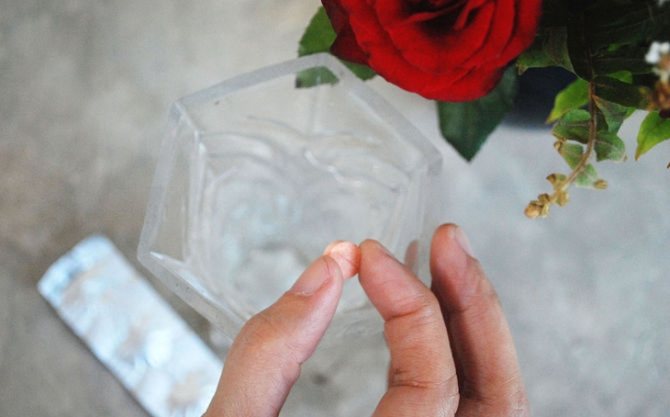

The quality of the water in which the roses will stand after being cut is of paramount importance. If you do not pay due attention to the preparation of water, it is unlikely that a bouquet of roses will be able to delight us for a long time with its freshness and beauty. We will find out how to make the water for a rose bouquet more nutritious and healthy.
Be sure to take either well-settled water, either purchased or distilled. In the summer, rain is also suitable. Pay attention to the container in which the bouquet will stand. The vase should be clean, without any residues from previous flowers.
Water temperature is important too. Take into account the time of year, season: in summer, roses will stand longer in cool water no higher than + 12-15 degrees, but in winter - in water at room temperature.
To prevent stem decay, it is recommended to add aspirin water. Moreover, the medicine should be placed in a vase after each water change. You can also use dishwashing detergent for the same purpose: it should be added in the amount of one drop.
The water needs to be changed frequently, renewing the cut of the plants with each change. The new slice should be 1–2 cm higher than the previous one.
You can add vinegar to the water: 1 dec. spoon for half a liter. This acidifier acts similarly to citric acid, in a peculiar way "preserving" flowers standing in water.
In addition, it can be added to ode and special solutions sold in flower shops. The components in these solutions are of artificial origin, however, they can significantly extend the life of the bouquet. As a suitable supplement, Chrysal Claire universal feed can be used.
Buds fall
Roses often drop buds. This may be due to the following reasons:
- Draft. If cold air gets on the plant during the airing of the room, this will lead to the fall of the buds.
- Cold irrigation water. With the appearance of an indoor flower, you should learn how to water a rose and how to care for it. If these rules are not followed, she will not only shed the buds, but may also die. To prevent this from happening, the plant is watered with settled water at room temperature. Cold humidification should not be carried out.
- Incorrect transplant. A room rose is moved to another flowerpot at a time when there are no buds on it. If this is done at a different time, then even if the roots are slightly damaged, it will drop them.
- Low humidity level. In the presence of such an atmosphere, spraying is carried out. During the procedure, make sure that drops of water do not fall on the buds, otherwise they will fall off.
- Lack of food. When the soil is depleted, the buds wither. To prevent this from happening, the plant is watered with phosphorus-potassium complex fertilizers. Failure to comply with the dosage also leads to the fall of the buds.
- Lack of light. With a lack of light, the rose slows down photosynthesis, which leads to the fall of the flowers.
- Pests.
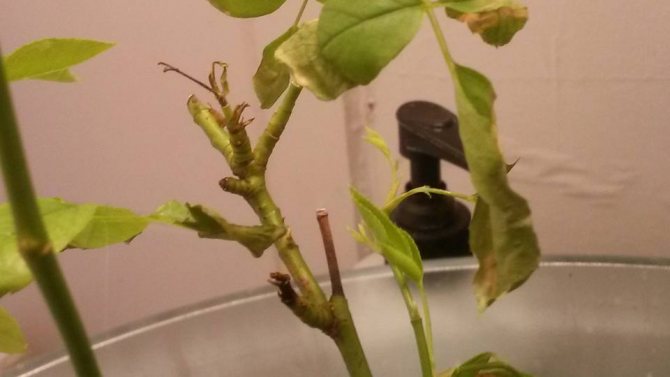

How to choose a vase
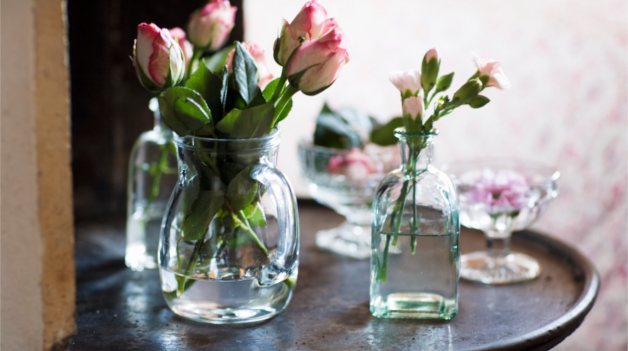

Let's find out which vase to choose so that the roses standing in it delight longer with their beauty and freshness.
If the bouquet is a decent size, voluminous, use a large vase with a wide neck. The shape of the vase is best of all cylindrical - such a vessel is both stable and attractive in appearance, and allows the plants to be provided with a sufficient amount of air and water. A bouquet of small standard parameters will feel good in an elongated graceful vase with a rather narrow neck.
You should know that the longer the stem of the rose, the more difficult it is for the water to go all the way from the tips of the stems to the buds. Therefore, it is better to use a special long vase for such bouquets. And the stems must be slightly shortened at an oblique angle.
It is better to take a vessel from a material that does not transmit light and is opaque.Ceramic works well, or frosted, tinted glass. The transparent material will heat up faster than will create favorable conditions for the growth of microorganisms.
Important: choose a vessel of such a height that the stems of the rose are submerged in water for at least a third of their length.
What to do with a rose after purchase?
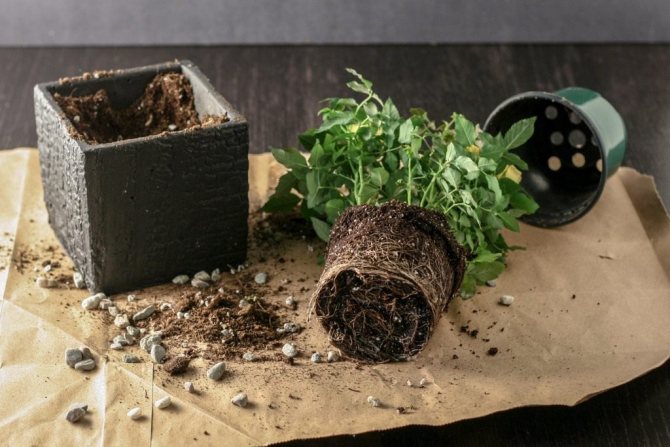

Indoor roses in pots need special care from the first days of purchase, since in the store their ideal appearance is maintained with the help of special fertilizers and dressings, and the cellophane packaging maintains the required level of ambient humidity. Once at home, such plants begin to wilt, shedding leaves and unblown buds, quickly losing their former attractiveness.
To prevent this from happening, the owner of the newly purchased plant needs:
- Free it from cellophane packaging, which in room conditions will impede normal air circulation, provoking the development of bacterial and fungal infections.
- Remove all dry stems and leaves with sharp scissors. Leaf blades with dried tips and all kinds of spots are also subject to removal.
- Cut off all flowers and buds from the bush. Otherwise, the plant will spend on their blooming the remnants of the forces necessary for the formation of the root system and adaptation to new conditions of detention.
- Treat the plant with solutions of insecticidal and fungicidal preparations (Fitoverm and Fitosporin).
- Transplant it (in case the flower grows in a too cramped pot or in one flowerpot - to give it more splendor - several bushes were planted at once). From a rose removed from a pot, rotted areas of the root system, as well as old roots, painted brown or black, are removed. Then it is transplanted into a new pot, the diameter of which is 3-4 cm larger and 6-7 cm higher than the previous one.
- At the bottom of the pot, it is necessary to pour a layer of expanded clay, the thickness of which should be at least a centimeter. In a pot without a drain hole, the thickness of the drain must be tripled.
The soil for a room rose can be prepared on your own by taking compost, river sand, soil from under coniferous trees, leaf humus (one part at a time) and three parts of sod land.
Having filled up the prepared substrate on top of the drainage, place the rose in a new pot and, firmly fixing the flower, pour it with warm water. It is recommended to spray a newly transplanted bush with a solution of the Epin preparation.
Where the bouquet will last longer
It is important not only to prepare the water and the vase correctly, but also to place the bouquet in the right place. Thus, all conditions for the long-term preservation of beauty and freshness by flowers will be met.
It is important to keep the roses out of direct sunlight, as the sun is guaranteed to cause both foliage and buds to dry out quickly. The best place for a bouquet is dark and cool. Flowers do not like drafts, so they should not be located near the vents and windows.
It is better not to keep cut roses in the same room with other flowers and houseplants. All flowers exude phytoncides - and therefore roses will fade faster, lose their appearance and aroma. In a polluted room - where people smoke, it smells like gasoline, a car, roses will not last long either.
It is better not to keep cut roses near the heater and air conditioner. Such a neighborhood will lead to the rapid fading of delicate flowers.
Now you know how to prolong the life of a bouquet of roses. It is better to take care of the flowers at the earliest possible stage - when the bouquet has just been presented. Timely measures taken will help prolong the life of flowers, protect them from premature wilting. And tips on resuscitation will help revive the flowers, even when they have already begun to wilt.
The presented bouquet can last from several days to several weeks, depending on how it is taken care of. First of all, you need to correctly place the roses in the vase.Fresh flowers, when purchased, immediately stand out with healthy dark stems, shiny green leaves, petals tightly pressed against each other. Unopened bouquet should be left at room temperature for several hours in order for the flowers to withstand the sudden change in temperature more easily.
Why do cut flowers fade quickly?
Most often, roses begin to fade in highly heated rooms, with drafts or insufficient air humidity. Therefore, you should not put them on a sunny windowsill or near heating appliances (the temperature should not exceed +18 degrees).
You can maintain the necessary moisture by regularly spraying the leaves with a spray bottle or covering the buds with a damp plastic bag.
Do not place flower vases near fruits. Especially many substances harmful to roses are found in citrus fruits.


It is not always possible to revive roses and bring them back to life.
How to revive roses
After that, you need to inspect the roses and process them. It is necessary to remove the packaging from the bouquet, to clean the lower part of the flower stems from thorns and leaves, as they can start to rot in the water. Once the stems have been lowered into the water, the cut can be refreshed. It is performed with sharp scissors or a special pruner obliquely - this way the stem absorbs water better.
The bouquet should be placed in a vase with settled water, as chlorinated tap water can harm the flowers. Roses do not like drafts and high temperatures, so they do not need to be placed on windowsills or near heating appliances. Direct sunlight also harms delicate flower petals. For a bouquet, it is better to choose a cool room with humid air and dim lighting.
In order to extend the life of the flowers donated, you can use these tips:
- periodically change the water in the vase, while updating the cut and removing the lower leaves and thorns on the stem;
- rose leaves can be sprayed with fresh water from a spray bottle;
- add a tablespoon of sugar, a teaspoon of citric acid or an aspirin tablet to the water for the bouquet;
- at night, the flowers are covered with a plastic bag, sprinkled with cool water from the inside.
The first signs of wilting include drying and curling of petals and leaves, while the flower heads are lowered. The easiest way to revive faded flowers is in the bathroom.... To do this, it is enough to fill the bathtub, cut the stems of the roses obliquely and place them in water. The buds do not drop as they may turn black. The bouquet remains in the bathroom overnight, and in the morning the refreshed flowers can be put back in the vase. This procedure is easy to carry out daily, prolonging the freshness of the roses for a long time.
How to revive roses after cutting
If the celebration for which the flowers were bought is postponed for several days, then it is necessary to keep them fresh. Cold water and a refrigerator will help with this.... After cutting or purchasing, the stems are placed in cold water for several hours, then you need to wrap them in a wet rag and thick paper, then place them on the lower shelf in the refrigerator. The condition of the flowers is checked periodically. Every day, roses need to be taken out of the refrigerator, the stems should be washed in warm water and the cut should be renewed.
And if the freshly presented bouquet withers?
If the newly presented roses "hung their heads" and have withered foliage, then you should not expect them to come to life.
After all, it is not known how long they stood in the store and what manipulations were carried out with them. In this case, you can leave the bouquet in a bath of water overnight, and in the morning pour boiling water over the slices. If this did not help, then, most likely, the roses will no longer be revived.
Read here our tips on how to extend the life of a bouquet of roses in a vase
Useful video
We offer you to watch an informative video about the resuscitation of a home rose:
If you find an error, please select a piece of text and press Ctrl + Enter.
Roses are grown not only in the garden, but also indoors.The flower growers appreciated the efforts of the breeders who presented the opportunity to keep such flowers on the windowsills. These miniature copies of garden representatives do not leave anyone indifferent, only that special care is required for these plants. Indoor roses dry up, often get sick, and are demanding about the conditions of detention. To save a beauty from death, you should know how to care for her.
If the newly presented roses wilted
This means that stale flowers have come to you, which have already been subjected to various tricks to preserve their presentation.


Frozen roses also wither quickly. In this case, it is difficult to say how to reanimate roses, because each of the methods may have no effect or have a short-term effect. Try to give them a drink at night in the bath, and if it does not help, then use the boiling water immersion in the morning.
Traditional methods, their advantages and disadvantages
Supporters of environmentally friendly gardening successfully use wild and ornamental plants to protect roses from wilting and other adverse effects. From them, infusions and decoctions are prepared, with which roses are sprayed to prevent diseases and pests.
- Against fungal pathogens –
- ash infusion - 200 g and mullein - 1 kg per 10 liters of water. Withstand a week, filter before spraying.
- milkweed juice helps well against rust... When the first signs appear, the affected leaves are rubbed with a broken shoot with white drops. If the disease has spread strongly, use a daily milkweed infusion prepared from 1.5 kg of crushed plants in 10 liters of water.
Some gardeners deal with rust with a 3% spindle oil solution.
The following plants will help against pests:
- Tobacco - 500 g per 10 liters of water is boiled and insisted in a warm place for 2 days.
- Bitter pepper - 600 g fresh (or 200 g dry) for 2 liters of water. First, the mixture is boiled, then kept for two days. Before use, filter and add water to 10 l (
Why does the indoor flower in the pot disappear?
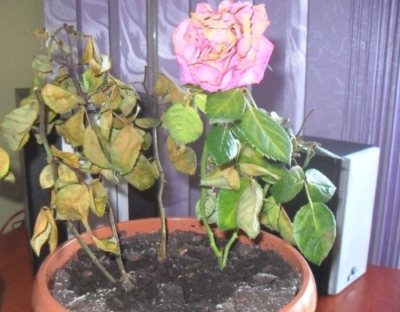

The most common reasons for the death of indoor roses include:
- lack of moisture (perceived especially painfully with a lack of trace elements and humus in the soil);
- high content of lime in the soil;
- excess moisture in the soil (often due to improper drainage or lack of it);
- lack of sunlight;
- diseases (such as cancer or rust);
- pests (for example, insect larvae).
When can't a plant be saved?
If the flower has managed to dry out completely, or the overwhelming part of its roots has rotted, no amount of resuscitation will help it. The prognosis is also disappointing if the plant is completely affected by mold or pests. In these situations, it is necessary to dig up and dispose of the affected plant in order to prevent contamination and death of neighboring plants.
If measures to resuscitate the flower do not give an effect, it is necessary to carefully dig or pull the plant out of the pot and examine its roots. If the roots are severely damaged by pests or rot, the last measure can help - pruning all old and affected shoots from the bush, which will facilitate its recovery. Cutting off dead roots is pointless, since it is impossible to restore them..
Useful Tips
You should not put a vase with a bouquet of roses on the windowsill if the sun's rays fall on it from the street. It is necessary to make sure that the flowers are not in the immediate vicinity of the fruit vases, especially those that emit ethylene, which is harmful to roses.
Using the listed procedures, the rose can be kept in good condition for about a month, turning it later into a herbarium, if it is very dear as a memory. To keep the buds dry, they are hung upside down. Wither rose petals can be used by pouring olive oil over them for a few days.
It is believed that flowers that were presented with love and from a pure heart last longer than those that formally marked a certain event.
Do-it-yourself flower resuscitation
What you need:
- water;
- sugar;
- paper;
- means for cut flowers.
If a bouquet of flowers was brought from a frosty street, do not shock it and carry it to the warmest place in the apartment. Find a cool room and leave the flowers there for half an hour. Later it is allowed to pick them up and put them in a heated room.
We cut the lower part of the stem into several parts. Withered leaves and dried buds are best removed.
Buds that have already begun to wilt need to be sprayed with water. Alternatively, a cloth soaked in liquid can be used. This will restore the buds and give them strength.
Fungal infections
Fungal diseases are difficult to diagnose. When spots are found on the leaves, it is most likely a spot. If the fears come true and do not take the necessary measures, then you can say goodbye to the flower.
The disease is contagious and contact with other plants will lead to their infection too. The fungus spreads and affects the weaker representatives of the flora, to which the rose belongs in the first place. The leaves will gradually dry out and gradually disappear altogether.
If negative signs are found on the bush, it is necessary to urgently remove the affected leaves and process the bushes, incl. and healthy, copper-containing drugs.
You can not spray the bush with water during the illness so that the infection does not spread further. It is important to provide quarantine for this bush, without contact with other plantings.
What oppresses the rose
What are the reasons for the lethargic appearance? This may be a violation of the rules of agricultural technology for growing roses, the occurrence of diseases or damage to plants by pests.
Failure to comply with agricultural techniques
- The first thing that comes to mind when you see withered roses is a lack of water. This often happens when moisture does not reach the roots of the crop, although the surface around the bush is wet. That is, watering should be sufficient to moisten the soil to the depth of the root system, and not just spray the surface of the rose garden. To retain moisture, it is necessary to mulch the surface around the bushes. However, you should not get carried away with abundant watering, the plant does not like waterlogging - everything is fine in moderation.
- Another mistake a gardener makes is exceeding the rate of fertilization for planting. From an excess of nitrogen, the leaves of roses look sluggish. But they are not flabby, but on the contrary, under the influence of nitrogen, the tissues grow intensively and become loose, heavy and sag. If you try to break such a sheet, it will crunch. With significant overfeeding, the plant may even die.
- Roses are very capricious plants, they love the sun and do not tolerate drafts. Shoots sometimes look lethargic when exposed to the wind. Therefore, the rose garden is arranged in sunny areas, protected from drafts.
- Roses are demanding on the soil. They prefer light, loose, fertile soils with a neutral reaction. Therefore, clayey lands must be diluted with sand and peat.
- Often, after heavy rains, the water stagnates, and the root system experiences a lack of air, signaling leaf lethargy. Drainage should be done in flooded areas.
- On poor soils, plants often starve and appear depressed. If the foliage is slightly yellow, and the veins are green, then these are symptoms of a deficiency of nutrients: potassium, magnesium, nitrogen, manganese. Feed your plants.
Read on to learn how to grow a rose from a cuttings.


gorgeous beauties
Primary processing
Now is the time to inspect and process the fragrant beauties.
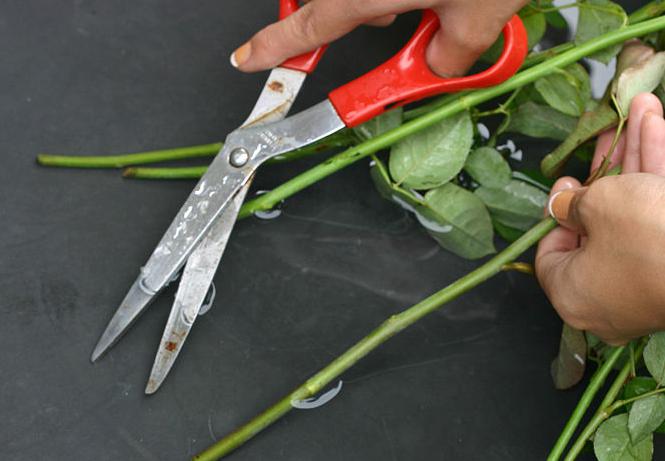

Remove the packaging and cut off all the thorns and leaves from the stem (about a third of the length) with a sharp knife. This is necessary so that they do not rot in the water. Dip the prepared stems in a bowl of water and renew the cut, it is better to cut it obliquely.For good moisture absorption, it is advised to split it a little with a knife and fix it with a piece of a match.
When buying roses, it is important to remember the key points.
- Proper delivery and good indoor placement will help the roses last longer.
- If the flowers have begun to fade, there are more than ten ways to revive them: using water, ice, baths, boiling water, saltpeter, alcohol, and more.
- If the flowers need to be saved before the holiday, use the refrigerator, before that, wrap the roses in a damp cloth and thick paper.
- By placing the bouquet in a cool place, you can enjoy its beauty for more than one week.
Indoor roses and hibiscus (Chinese and Syrian roses) decorate the house and delight the eye with bright colors. But sometimes their leaves turn yellow, become stained or crumble. Trying to save a favorite flower, the owners often only worsen its condition. To quickly revive the plant, you need to determine what caused the painful condition. The main problems when growing roses arise when the temperature regime is not observed and the air is too dry.
- Show all
How to carry out the correct diagnosis
If the roses have withered, this is a signal that an urgent need to determine the cause of the unfavorable condition of the plant.
You need to carefully examine the bushes in order to identify characteristic signs by which you can establish what exactly is happening with the plant.
- If a leaves turned yellow partially so that green streaks are visible, this means that the roses lack nutrients, nitrogen, potassium, magnesium, manganese.
- With an excess of nitrogen, the leaves hang, but if you look closely, they are not sluggish at all, but


Often, the edges of the chlorotic leaves drop downward, and it looks as if they have withered.
loose and heavy. If such a sheet is broken, it seems to crunch. - When no damage is visible on the bushes, and the unopened buds wither, most likely, larvae have wound up inside the stem rosewood sawdust.
Leaves, rolled into a tube or "crumpled", look withered. This "worked hard" leaf roll.
- Diseases of roses, as a rule, differ not only by wilting, but by characteristic signs:
| Name of the disease | a brief description of | Photo |
| Powdery mildew | Looks like a fine whitish powder | Powdery mildew |
| Black spot | Strikes the leaves with dark circles | Black spot |
| Septoria | Spreads out as white circles with a black rim | Septoria |
| Cyprosorosis | It spreads in brown spots of irregular shape. | Cyprosorosis |
| Rust | Covers the leaves with a red, fluffy bloom | Rust of roses |
Almost always, with diseases, rose leaves wilt partially or completely, up to premature fall.
If there is no damage, and the soil is dry and hard, like a stone, then the roses have definitely withered from lack of water.
Little secrets
Before figuring out what steps to take to bring the plant back to life, it is worth taking into account the tricks that flower growers use. For example, as soon as you have received a bouquet, put it in pre-separated water. If you simply take it from the tap, there will be too much chlorine in the composition, and this does not have the most favorable effect on the condition of the roses. Decide immediately where you are going to put the vase of flowers. It is undesirable to give preference to places near open windows, because they do not tolerate drafts quite well. Another important point: do not place roses near heating appliances. Try to find a place where the flowers are not exposed to the sun's rays. As a rule, the optimal temperature regime for a flower is +18 ° C. If your home is much warmer, it is recommended to put the plant in the coolest room for at least a couple of hours a day. If the donated rose wilted, it's time to take on the following tips from experts:
- It is imperative to change the water, and regularly.Try also to gradually shorten the cut of the stem, and remove the leaves that are in the water.
- Roses are very fond of not only moist soil, but also moisture in general. Feel free to spray them from time to time from a spray bottle.
- Another effective method: every evening a bag is put on the flowers, sprayed with water from the inside. This moisturizing treatment will have a beneficial effect on your flower.
- Sugar prolongs the life of roses. For 1 liter of water, you will need about 20 g of sugar. In this case, the flowers will last much longer.
Flowers are the best gift
One can argue with the assertion that flowers are an obligatory attribute of a holiday and the best gift in all occasions of life, but each of us had to hold this short-lived miracle in our hands more than once. In the general context of fun, high spirits and joyful excitement, a luxurious bouquet of roses is really necessary and looks gorgeous.
But the holiday ends, the makeup is washed off, the masks are removed, and a sad reminder that everything passes away, there remains a bouquet fading in a vase - dying flowers, initially doomed to death. Still living plants do not raise a hand, and it is painful to witness this quiet agony, calmly watching their slow dying. It is impossible to restore life to flowers cut off from the root, it remains only to prolong their life.
Shock therapy
You can also revive the donated roses using much more effective methods. To do this, the bouquet is soaked in water, in which you will need to first add a little alcohol and ammonia. Don't forget to shorten the stems as well. That being said, it is very important to remove the thorns and leaves that fall into the water when you return the bouquet back to the vase. Shock therapy is done in different ways. There is another common method that can give freshness to even drooping buds. To do this, place the entire bouquet in a bath of cold water, while removing leaves and thorns as much as possible. A little boiling water must be added to the area of the lower cut of the stem. This procedure can significantly refresh your flowers. Thus, they will look beautiful again and will stand in a vase for a long time. The main thing is to know what shock methods are recommended to be taken in such situations.
Serious mistakes gardeners make in eliminating wilting roses
- Watering roses with cold water.
Gardeners often wonder why roses wilt, even if they are of normal color and show no signs of disease or pest damage. This happens if the plants are watered with cold water from a well or deep well. Roses get stress from this, because they are perceived as an adverse effect. It is easy to eliminate this if the water is warmed in tanks. By the way, at the same time heavy particles settle to the bottom. For example, settling water is a reliable means of combating excess iron, which is harmful to roses (
Classical resuscitation
If the flowers have wilted and simple measures do not help, there is one tried and tested method. A simple cold bath, in which you can immerse the whole bouquet, has a revitalizing effect. It works especially well if the rose is already "second" fresh.
It is important before this to cut off the tips, remove the lower branches and leaves. You also need to make sure that the water covers the entire flower, and the buds are at least half drowned. After the bouquet has already been taken out, let all excess water drain off.


Infectious diseases
In addition to fungi, the rose bush can infect infectious diseases - bacterial cancer. It manifests itself as reddening and thickening of the stems and roots, and round spots also appear.
After the leaves and stems die off, this type of infection lives in the ground for several more years. In this regard, you should get rid of such soil so as not to infect the next plants that will be planted in this pot. After removing such soil, the pot must be disinfected and, if possible, boil for a few minutes.
There is also such a disease as room rose jaundice. The carriers of this disease are insects. Diseased leaves become yellowish, gradually wither and if the spread of this disease is not prevented, then it will lead to a disastrous outcome.
Weak areas of the bush should be cut off and burned. If the flower itself has suffered greatly from this, and there is no way to revive it, then it is necessary to burn it as well so that the infection does not get into the soil and does not infect other plantings, even if they grow on the street.
Roses are prone to infectious burns. The leaves begin to dry from the center, gradually becoming completely brown, with a pink border. These areas quickly spread in rooms where there is not enough oxygen, i.e. poorly ventilated. If you do not miss the moment, then the flower can be saved by cutting off only the affected leaves.
Powdery mildew is the second most common indoor rose disease after spider mites. The white color of the leaves immediately signals a disease. It develops instantly and leads to the death of the flower.
Having noticed the infection, you do not need to hesitate, it is important to immediately start cutting off the infected leaves and buds. If the disease has affected more than half of the plant, then it is necessary to cut the bush, leaving the shoots 5 cm above the ground. Necessarily, followed by spraying with a special solution purchased at a flower shop.
How to refresh roses
It is advisable to put the bouquet in a cool place every night. Roses can simply be put in a bathtub half full of ice water. In the morning, the flowers return to the vase.
Instead of a store-bought fertilizer, you can use a small spoonful of sugar. It is poured into a vessel where the cut plants are located.
If methods of how to revive roses in a vase do not help, the last resort remains. The flowers are taken out of the liquid and hung down with their heads. When they begin to dry out, this position will help fix the original shape. Dried plants can be stored in a herbarium.
In order for the roses in the vase to last longer and delight you, you need to properly care for them and, provided that you have been presented or bought fresh roses, these beautiful flowers can last even for several weeks. Of course, sooner or later, roses begin to fade and we will tell you how to revive them in this article.
If you brought roses from the frost, then immediately do not rush to put them in the water, they first need acclimatization, remember about the New Year's live tree, which also cannot be immediately put in the apartment, and first leave it on the balcony to get used to it. The same is with roses, but it is only better to send them to the refrigerator on the lower shelf, and if the stems of the roses are so long that they do not fit in the refrigerator, then the balcony will do. The bouquet should be wrapped in newspaper and left for several hours in the refrigerator or on the glassed-in balcony. The inside of the vase must be clean, otherwise any bacteria will multiply quickly and infect the flowers. Therefore, you need to add an aspirin tablet to the water in a 1: 1 ratio, as well as 1 teaspoon of vinegar and 20 grams of sugar for feeding. You can add, instead of the above, a tablet of activated carbon, it will also help not to develop bacteria.
The water must be settled. The water should be changed daily, and the vases should be washed from the inside with a detergent, which, by the way, will not harm the flowers at all, as it destroys bacteria. When replacing water, remember to add aspirin, vinegar and sugar or activated charcoal. Also, every day you should make a fresh cut of the stem of each rose under running cool water, or you can draw water into a container or pan, lower the stem into it and make a slanting cut under water, which will be even easier. It is better to make a cut with an assembly (construction) knife, because this tool is sharper. In no case should you make a cut with a blunt knife or scissors, you will get torn edges that will only harm the plant. The cut should be as long as possible.Remove thorns and leaves that get into the water.
Place roses in a vase in a slightly shaded place and, most importantly, there are no drafts. Therefore, if a vase of flowers is on the windowsill, opening the window for airing the room, it is better to take the roses out of the room to another place where there will be no drafts. If it so happens that the purchased one will be needed in a few days, for example, the discharge from the hospital is transferred or the celebration of something is postponed from the middle of the week to the weekend, and the bouquet has already been bought, then you can save it in its original form. To do this, wrap it in a wet cotton (not synthetic) cloth, wrap it on top with thick paper and put it in the refrigerator on the lower shelf. Every day, the cloth should be rinsed in clean water, wrapped again, on top with a new layer of paper and poisoned in the refrigerator.
The fallen roses are reanimated with the help of the following solution: 2 teaspoons of alcohol and 1 teaspoon of ammonia are added to 4 liters of water, but just 1 tablet of aspirin is also suitable. At night, roses should be bathing in the bathroom, for this you should take a bath with cold water and immerse the roses in it up to the buds, for which you need to build something in the water to support the rosebuds and prevent them from getting wet. Ideally, a piece of styrofoam with holes made in it will fit into which roses are threaded.
Potato juice treatment
How to save a rose? You can also use simple potato juice for this. The remedy can be found in any home. It is also a great way to save a bouquet if there is no water at all in the house.
The stalks, cut at an angle, are stuck straight into the potatoes. Rich juice, active substances, the very pulp of root vegetables can revive roses that have spent without water even all day.


You can add the juice itself or the grated pulp to the water, if you have one at hand. This will enrich the rose and give the bouquet all the nutrients it needs.
How to revive at home?
Consider how to reanimate the plant and what to do first if the home flower dies. If you need to resuscitate a room rose, the following measures may be helpful.
Transfer
A transplant will help correct the situation in cases associated with the improper composition of the soil or the activity of parasites that live in it. Transplanting is very traumatic for the root system of a room rose, therefore, to prevent damage to the roots, you need to act as carefully as possible. It is recommended to perform the transplant as follows:
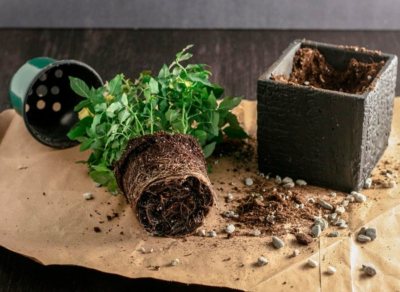

- First, outline a circle for digging in the bush with a small spatula, choosing such a diameter so that there is no damage to the lateral roots.
- Then the bush is dug in from all sides for the sake of convenient extraction of an earthen coma with roots.
- They pick up a lump with roots with a shovel and, turning it over in a hole, put it on its side.
- After that, the bush is removed from the pot, placed on a piece of cloth or plastic wrap and wrapped in it to prevent the earth from shedding when moving.
- Before transplanting, rose bushes are watered abundantly with water, transferred to a new place and placed in a pit so that they do not lie deeper than they were before transplanting.
- After the end of the procedure, the rose bush should be cut off and watered with plenty of water.
Revitalizing by the cold
How to bring roses to life? Cold can give them a second chance, which will help restore their freshness, since these flowers are thermophilic. We do it this way: wrap the entire bouquet with a damp towel - from buds to tips, wrap it in newspaper (only very carefully so as not to harm the leaves) and put it in the refrigerator. The bottom or middle shelf works best.
It is better to leave it overnight - then the bouquet will interfere less with the home. In the morning we take out the reanimated roses and look: they should look like new ones, just cut.


